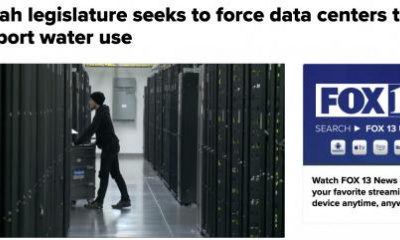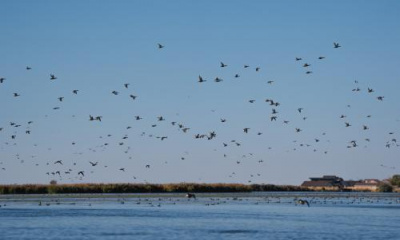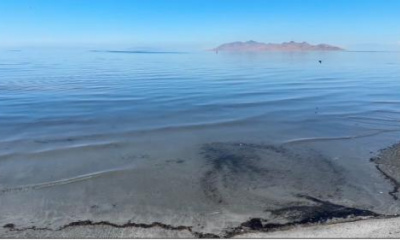Former governor says the plan will be state led, not influenced by a developer.
Lawmakers are looking to Utah Lake to help refill the Great Salt Lake, but they might be dredging up a controversial idea to do it.
Sen. Curt Bramble, R-Provo, announced he opened a bill file Tuesday that will provide around $2 million to research whether Utah Lake, the state’s largest natural freshwater lake, can also save the largest saline lake in the Western Hemisphere. The two are connected via the Jordan River.
“The whole idea here is Utah Lake is one of the primary contributors to the water supply of the Great Salt Lake,” Bramble said during media availability on day 15 of the general session. “How can we capitalize?”
The bill has not been publicly released. Neither Bramble nor Senate leadership shared much detail about the plan, only noting that the study will be “scientifically based” and that former Gov. Gary Herbert “was the instigator of the idea.”
“We want it to be a defensible study,” Bramble said, “that’s not biased based on special interest objectives.”
The lawmaker added he has discussed the plan with scientists from Brigham Young University and relied “heavily” on Utah Valley University’s Herbert Institute, a policy think tank named for the former governor.
“Former Gov. Herbert is involved in it,” Senate President Stuart Adams repeated.
Reached by phone, Herbert said he has contemplated solutions for Utah Lake since he first entered politics. As a Utah County commissioner in the 1990s, he was involved in a study with Clyde Nayor, the former county engineer, that explored building a causeway across the lake to meet traffic demands for a growing population on the west shore.
“Clyde was the visionary on that,” Herbert said, although he acknowledged the causeway never moved beyond concept. “That’s been the history of Utah Lake. They talk about it, study it and it never happens.”
Decades later, the Great Salt Lake’s dropping elevation has pushed it to the brink of collapse, compelling lawmakers to take action. And Herbert said Utah Lake might be part of the solution.
“Can we get water from Utah Lake to Great Salt Lake to preserve it?” Herbert said. “Maybe we could reduce the surface area of Utah Lake and minimize so much evaporation.”
‘Strategic dredging’
Like the Great Salt Lake, Utah Lake is large and shallow and loses a tremendous amount of water through evaporation each year. Asked what he thought could be done to slow those losses, Herbert floated a familiar — and contentious — idea.
“How you do that, where you do that, what that entails, whether it’s strategic dredging, that’s what the study would be put together to find out,” Herbert said.
Utah lawmakers and resource managers have looked to conservation and leasing water from agriculture as their preferred policies to reverse the Great Salt Lake’s decline. The idea of a pipeline to another water supply has also resurfaced. But the Great Salt Lake’s sister freshwater lake, Herbert said, may also hold a viable opportunity.
“If you really want to save the Great Salt Lake, rather than take water from agriculture and farmers, there may be other ways to move water,” Herbert said. “The thing I like about the concept is, if it works, you’re not stealing anyone’s water.”
Lawmakers have supported the idea of dredging Utah Lake since 2018, when Herbert was still governor.
That previous push involved a private company, Lake Restoration Solutions (LRS), taking lakebed sediment and building an island city of half a million people, not rescuing the Great Salt Lake. LRS claimed with little proof that dredging and deepening Utah Lake would solve its persistent issues with algal blooms and invasive species. Scientists, local elected officials and Utah Lake advocates pushed back on the island-building idea, however, worried about the ecological toll dredging would take.
The plan imploded in 2022 when state officials deemed it unconstitutional. LRS filed for bankruptcy last year. But it left a mess in its wake. The lakeside town of Vineyard continues to grapple with political tensions after residents learned their mayor backed LRS’s plan and pledged city funds to support it. The Utah Lake Authority had a shake-up in leadership after the board learned its former executive director had also pledged public funds he didn’t control to the project.
BYU ecology professor Ben Abbott, a particularly vocal critic of the dredging plan, was dragged into a defamation lawsuit. He abruptly lost a state-funded watershed research grant, which the professor suspects lawmakers pulled in retaliation.
“This is a new beginning,” Herbert said. “Whatever the mistakes of the past are, they’re mistakes.”
This latest Utah Lake study, Herbert added, will be more collaborative. And it won’t be at the direction of a real estate developer.
“The state being the lead on this lends a lot of credibility,” he said.
Bramble’s bill hasn’t been released yet, so it’s unclear whether it will specifically mention dredging.
“They will be looking at all options,” a spokesperson for senate leadership wrote in a text message when asked about dredging. “Sen. Bramble doesn’t want to influence the process of naming anything the recommendation may or may not include.”
Expert cautions on ‘re-engineering’ Utah Lake
In an interview, Abbott said both Bramble and Herbert have reached out to him about their latest Utah Lake plan. Dredging didn’t come up, he said, but the professor was clear — making Utah Lake deeper won’t reduce its rate of evaporation.
“There is a sense of discouragement and resignation about what appears to be a lack of reckoning with some of the mistakes that were made” involving Utah Lake in recent years, Abbott said. “It’s convenient to just sweep it under the rug.”
But Abbott said he would like to see greater accountability over what happened in the LRS debacle, including why lawmakers gave such unwavering support to a costly idea with no scientific basis.
“There continue to be discussions about re-engineering Utah Lake and Great Salt Lake, like making the lake smaller or deeper,” Abbott said. “That doesn’t lead to good outcomes.”
The solutions lawmakers explore also should not pit the two lakes against each other, Abbott added, but look at supporting the wider watershed as a whole.
“Given the size of the state budget,” Abbott said, “it would be a real tragedy to not get the best available science in place for these crucial ecosystems.”
Salt Lake Tribune reporter Bryan Schott contributed to this story.







